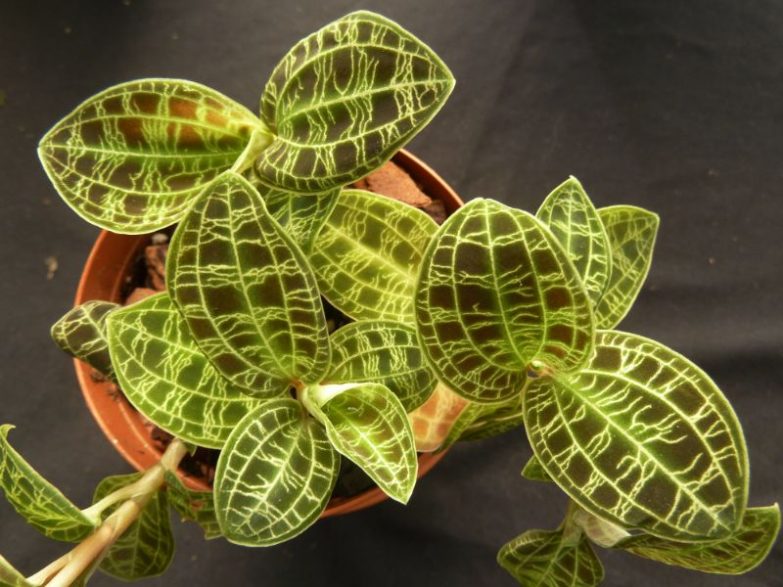The Macodes petola is an unforgettable jewel orchid with amazing leaves that seem to literally light up a collection. Though it’s not the easiest houseplant to satisfy, with correct care it can thrive and keep people talking. In this article, we’ll explain everything you need to know about Macodes petola care, to keep this unique gem thriving.
Bright or moderate, indirect light and warm temperatures of 65-85ºF (18-29ºC) year-round are essential to providing good Macodes petola care. The soil should be loose and well-aerated with good water retention; it should never become overly dry or soggy. Fertilize lightly on a regular basis and provide moderate to high humidity.
Macodes Petola Overview
Macodes petola is a jewel orchid that grows in soil beneath the forest canopy rather than as an epiphyte. Grown for its phenomenal foliage instead of flowers, the plant requires different treatment than other members of its famous family.
Their rounded, broad leaves have a velvety texture and feature thin, webbed “lightning bolts” of lighter color on a dark green background. The remarkable netted pattern sparkles in sunlight and produces an electric effect.
Macodes petola has a creeping rhizome and sprawls over the ground. Its evergreen foliage emerges in loose whorls to form rosettes up to six inches long.
This unique orchid is indigenous to rainforests in Southeast Asia including Malaysia and numerous Pacific islands. It lives in forest shade at lower altitudes where it bathes in a warm, moist environment.
It’s hard to believe the stem spikes with tiny flowers that emerge in late fall are cousins to the extravagant blooms of other orchids. The Macodes petola‘s modest white blooms “feature” off-white centers.
Though vulnerable to rot, the plant isn’t overly fussy if you meet its basic requirements – it is, after all, a weed in its native land. An excellent candidate for a terrarium, the Macodes petola can also flourish as a regular houseplant if optimal moisture is maintained.
The plant’s trade is restricted due to over-collection, but tissue culture is gradually making it more available.
Macodes Petola Care Summary
| Scientific Name | Macodes petola |
| Origin | South-East Asia |
| Light Requirements | Bright, indirect light is essential for good Macodes petola care. Leaves will fade and scorch in direct sunlight. |
| Watering | Essential to keep the soil consistently moist, but not soggy. Try not to get the foliage wet when watering. |
| Soil | An equal mix of peat or coco coir and perlite works well. Sphagnum moss alone, or in combination with peat and perlite works well too. A light, exceptionally well-aerated, and moisture-retentive mix is essential, regardless of the soil components. Here are some great pre-made mixes. |
| Temperature | 65ºF (18ºC) to 85ºF (29ºC), although it does best in the upper half of this temperature range. 60ºF (16ºC) is a safe minimum |
| Fertilizer | A quality, water-soluble fertilizer with a balanced ratio is suitable. Apply at 1/4 strength every four weeks, or apply a very low concentration using a “weekly, weakly” regime. |
| Humidity | High humidity is preferable, but not essential. Humidity of 50-70% is excellent, but keeping the growing medium and roots moist is much more important than maintaining high humidity. |
| Flowering | Macodes petola flowers are white with chocolate or pale green centers and form along a stem spike that reaches up to ten inches high. Flowers are unimpressive and some growers cut the flower spikes before blooming. |
| Pruning | Prune to remove old or dead foliage and to maintain the size of the plant. |
| Propagation | It can be propagated from offsets, stem cuttings, rhizome division or air layering. Propagating Macodes petola takes time and patience. |
| Re-Potting | Will continue to thrive when rootbound as long as its care needs are met. Repotting will prevent restriction of growth. |
| Diseases and Pests | Average susceptibility to pests. Prone to root rot and bacterial and fungal foliage disease. Slow to recover due to its slow growth rate. |
| Toxicity | Macodes petola is non-toxic to humans and animals. |
| Where To Buy | Buy Macodes petola online at Etsy (I buy most of my houseplants from Etsy). |
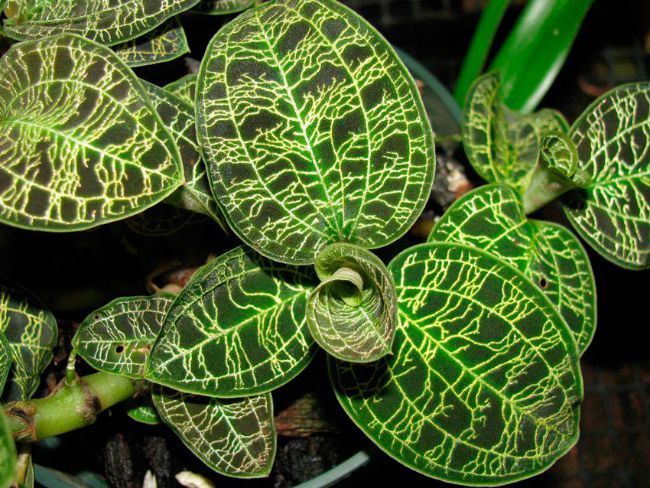
Keeping Macodes Petola In A Terrarium
Besides helping to provide consistently damp soil, terrarium living is well-suited to the plant’s need for high humidity and temperature. Its small stature and low light requirements are other reasons the Macodes petola does well in terrariums.
A terrarium makes it much simpler to keep the soil optimally moist. It’s also easier to water indirectly and keep the leaves dry: terrarium specimens often have brighter and more colorful foliage. For more info on making and looking after a closed terrarium, read this article.
The main caveat is that a lack of air circulation can lead to fungus or rotting in a humid system.
Macodes Petola As A Houseplant
You can provide excellent Macodes petola care in the conditions of most normal homes, too. This has some advantages.
The warm temperatures that the plant loves are easy to provide indoors (beware of cold windowsills!), and its low light requirements make a suitable spot easy to find.
A potted plant won’t creep into other plantings, either. It easier to groom and fertilize a houseplant, and there’s always space to propagate. Finally, if you find pest or disease issues in your collection, a container is easy to isolate and/or treat.
Humidity is important but, unless your space is extremely arid, keeping the soil properly moist is even more critical. The plant can thrive as long as the soil doesn’t get too sodden or too dry.
Macodes Petola Light Requirements
This is a rare plant that appreciates low light. In fact, their leaves fade if the light is too bright. Direct sun scorches them quickly.
A sheltered north-facing window is a good option but keep them well back from a sunny windowsill.
If your plant is leggy and stretches toward the light, it’s asking for more illumination. The Macodes petola does well with artificial LED grow lights if you need to supplement their environment.
Watering
Recommendations for the Macodes petola often focus on high humidity, but it’s important to emphasize that proper soil hydration is even more critical. It’s a balancing act, though.
Their roots should never dry out – but they shouldn’t be overly wet, either. Root rot can set in easily. The soil needs to remain well-oxygenated.
Considering that the medium is suitable, the trick is to find the right tempo for watering. Learning the weight of the pot when it needs water is one quick way to monitor their status; checking with your finger is another good method.
More tips:
- Even after you’ve discovered the appropriate watering interval, don’t rely on a schedule … check the soil each time! Read my top watering tips here.
- Humidity affects how often you’ll need to water, as does the pot’s material: clay pots encourage faster evaporation.
- Water less in cooler weather or when the plant isn’t actively growing.
- If you’re using moss, keep it damp but not wet. Some growers mist the substrate to maintain slight moisture, which can also be useful in a terrarium.
- It’s best to use purified water, especially if your tap water is heavily mineralized. Always use dechlorinated water. Read more about the impact of water quality on your plants.
- The Macodes petola dislikes wet leaves! Water at the base of the plant to keep the foliage dry. Bottom watering is another option.
- Some growers have success with a semi-hydroponic system. This system uses a water reservoir beneath the soil’s container and wicking material to keep the soil damp. It can help maintain evenly moist soil without constant attention – but it must be set up correctly and monitored.
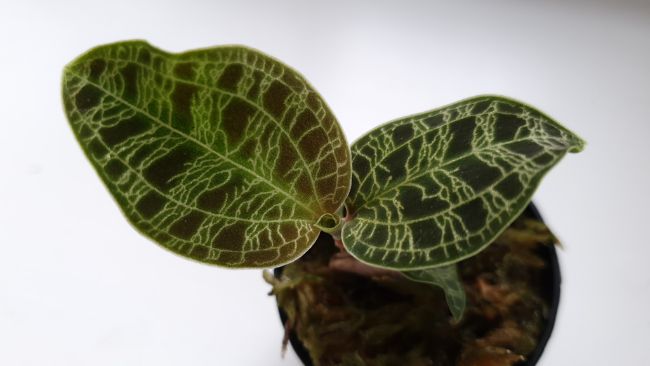
Macodes Petola Soil Requirements
Your Macodes petola‘s soil should retain moisture while preserving oxygen for the roots. The pH should be neutral or slightly acidic. The soil needs some fertility, too.
Soilless mixes can work if you add nutrients, but traditional bark-based orchid media may not retain sufficient water. Getting the right soil will make all other aspects of Macodes petola care so much easier.
Here are some soil options:
Sphagnum Moss – Perhaps the most popular solution. Don’t pack the moss down too firmly. Keep it evenly moist because dry sphagnum can be hard to rehydrate. It can also become over-saturated with regular watering: some growers just mist sphagnum whenever its surface dries out. Note that sphagnum retains more water as it decomposes.
Peat Moss/Coco Coir/Perlite – This soilless mix provides adequate structure, aeration, and water retention, but be aware that peat decomposes and compacts over time. An equal mix of peat/coco coir and perlite works well. Water should run through the pot rapidly.
Layered Substrate – Using layers of different materials is a popular method of terrarium planting. A mix of bark and perlite over a sand or gravel base with a top layer of sphagnum helps preserve oxygen in a moist environment.
African Violet Base Mix – Some growers add peat or coco coir to quality African Violet potting soil for additional water retention.
Compost / Leaf Litter – You may be tempted to go the natural route and replicate the humus-rich organic soil of a forest, but organic elements decompose rapidly when kept moist; they quickly acidify and lose oxygen-carrying capacity. Organic material needs amendments such as perlite or coarse sand for aeration.
Humidity Requirements
Macodes petola care is definitely easier with high humidity of between 50% to 70% … however, humidity of over 80% can trigger moisture-loving pathogens like mold and fungus. High levels reduce leaf transpiration (water loss) and reduce the need for watering
Remember that root hydration is the biggest issue. High humidity is desirable – it’s one reason they do well in terrariums – but maintaining root moisture is vital.
Say No To Misting
Simple solutions like grouping plants or adding humidity trays can raise humidity slightly, but misting isn’t a good idea. It can bring on fungal and other moisture-related problems, and misting doesn’t raise humidity long enough to provide much benefit.
Temperature
The Macodes petola demands an odd combination: it likes damp, shady spaces along with high temperatures. It’s like a mold recipe.
The plant grows best in a warm range from 75ºF (24ºC) to 85ºF (29ºC), so if you’re not getting the growth you’d like to see, check the temperature.
They don’t mind cooling off a bit in the evening to about 65ºF (18ºC) but consider 60ºF (16ºC) a safe minimum. They are not frost tolerant.
Fertilizing Macodes Petola
The Macodes petola is not a super-fast grower and doesn’t need a lot of fertilization, but it does need some ongoing support during the warm season.
A quality, water-soluble fertilizer with a fairly balanced ratio of around 7-5-6 is suitable. This is preferable to orchid specific fertilizers, which often have high phosphorus levels to promote blooming.
Organics are generally the safest choice but pay attention to the NPK ratio to keep the right balance of nutrients. Use a liquid formula for accurate measurement and even application.
Macodes petola takes in nutrition through its leaves. Young plants may even absorb more nutrients through foliage than from their roots.
Note: Whatever schedule you decide upon, don’t give them a heavy dose. Feed small amounts more frequently to avoid chemical burns.
There are two common methods used for feeding a Macodes petola. Remember, these regimens are only for the warm growing season. If your plant isn’t growing, don’t feed it!
Monthly – Dilute your fertilizer to a quarter of the amount suggested. Consider a supplementary foliar feeding to avoid overdosing the soil.
Weekly – Jewel orchids are amenable to a “weekly, weakly” schedule. You can divide the dose between foliar and soil fertilization … but go lightly.
Another way to provide a foundation of nutrients is to add an organic amendment like bloodmeal to the soil. Again, not much! Some owners add eggshells to ensure sufficient calcium in the soil. Read my guide to fertilizing houseplants to learn more.
Flowering
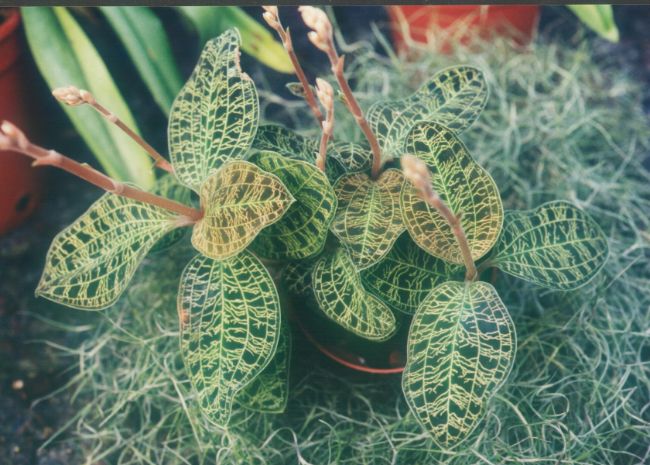
You might think that a plant with leaves like a Macodes petola doesn’t need to have stunning flowers – which is fortunate, because it doesn’t. Unlike the head-turning floral display other orchids put on, this plant’s blooms are only an afterthought.
The sparse flowers are tiny, about 1/3rd of an inch wide. They are white with chocolate or pale green centers and form along a stem spike that reaches up to ten inches high.
The Macodes petola blooms in late fall … the flowers last a few weeks if the temperatures are mild.
Many growers cut the flower spike before blossoms form because the plant tends to grow loose and leggy after blooming. Reducing water may help reduce this tendency.
Simple Pruning
It’s unlikely you’ll want to prune the amazing leaves, but there are a few reasons it could be necessary:
- Grooming the plant by removing dead or damaged foliage is important maintenance.
- The Macodes petola can outgrow its space, especially in a terrarium.
- The stems are prone to breaking if they get long or leggy. You may want to control the process.
You can trim leaves at the base of their stem with a sterile blade … but breaking them off may work better at inducing (minor) branching in the remaining stem.
Pro Tip: You can often propagate the broken piece by sticking it back into the pot’s soil.
Repotting Macodes Petola
The Macodes petola isn’t overly sensitive to being (gently) repotted, but don’t do it frequently. After you bring it home, let the plant acclimate before repotting to avoid further shock.
Here are some tips:
- Gently unpot the plant and inspect the roots. Check for root rot, and remove any infected portions.
- Use a wide, shallow pot to give the creeping rhizome room to sprawl and reduce empty soil space.
- If you are repotting into a larger container, only go up one size (about an inch in diameter).
- Carefully remove up to 50% of the old medium from the root system.
- Don’t pack the soil down; leave it loose.
- Changing the soil volume alters the need for water, so monitor the medium carefully after repotting.
- Providing optimal Macodes petola care after repotting will ensure your plant resumes normal growth quickly and without incident.
Propagation
Asexual reproduction is the common method for propagating Macodes petola. New plants will be genetically identical to their parent.
Always use sterile tools. The plant is vulnerable to infection from cuts. Wiping the blade with isopropyl (rubbing) alcohol does the trick.
Offset Division – The easiest method is to divide clumps or offsets and raise them as individual plants. Carefully separate the offset; you may need to unpot the plant for the cleanest separation. Try to ensure the offset has developing roots to give them a good start.
Stem Cuttings – Start new specimens by planting a stem cutting in fresh mix. Give them the same moist soil as the mother plant.
If the humidity is low, it can be helpful to place the container in clear plastic. Remove the covering frequently to air out the plant and keep fungal problems at bay.
Note: The stems aren’t usually fast-rooting enough to start in water. Rot is likely to set in first.
Rhizome Division – This can be tricky because you must keep the soil damp enough to keep the plant growing and happy, but not so moist that it encourages rot.
Make cuts so that each segment has at least one growth node. Creeping rhizomes grow near the surface, so don’t replant deeply: press it into the soil and lightly cover it.
Air Layering – This method is more work, but it’s helpful if you have trouble rooting your cuttings. It involves wounding the stem, applying root hormone, and wrapping the area in moist sphagnum moss. The wrapping is sealed until roots form. This technique is useful on leggy stems.
Have patience – each of these propagation methods takes time. Replanting offsets is normally the quickest, but babies can languish without apparent growth for several weeks. Don’t try to stimulate them with fertilizer, extra watering, or bright light.
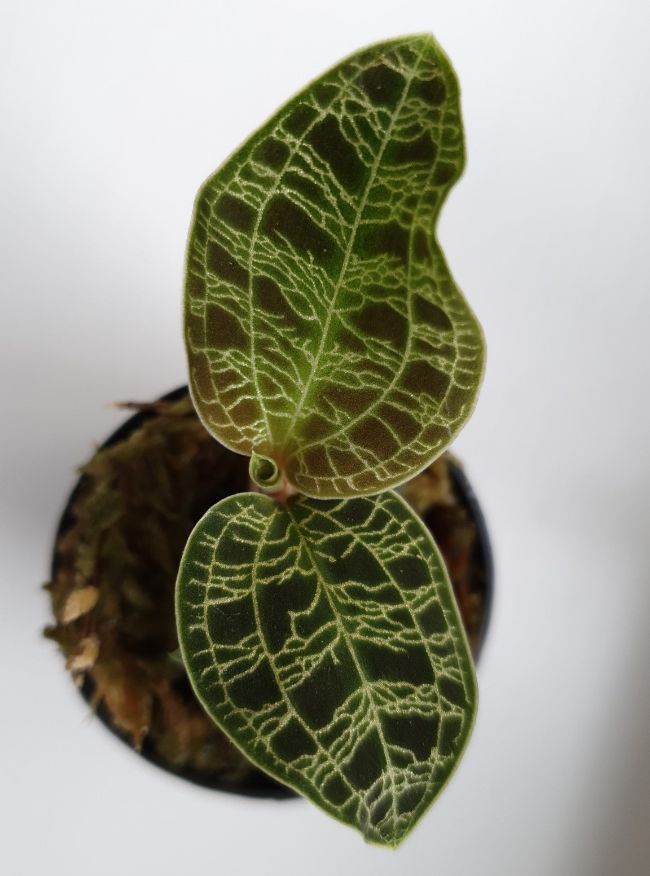
Tips For Macodes Petola Care
- Be careful with the leaves. They are fragile and break easily if you bend them.
- A Macodes petola takes time to establish itself after a relocation or transplant. Some wilting or foliage loss is to be expected.
- The plant does best with good airflow; this is one drawback to a closed terrarium. A small, inexpensive fan can be an unobtrusive solution.
- Don’t get upset if the top of your sphagnum moss turns green: it’s just algae. As long as it doesn’t get out of hand, it’s unlikely to hurt the plant. Spraying with a diluted solution of hydrogen peroxide can reduce its presence.
- Flush the soil when watering by letting it drain freely out the drainage holes.
- If you encounter root rot, the plant may recover if you treat it like a cutting. Trim off the rotting roots and dip in rooting hormone before replanting in fresh mix – discard the infected soil!
- If your plant has gotten leggy and lost its lower leaves, you may be able to restore it by cutting off the leafy portion and regrowing it as a cutting.
Toxicity
Jewel orchids are non-toxic to people and animals, including dogs, cats, and horses. The Macodes petola is commonly grown in vivariums with reptiles and other animals without reports of poisoning.
Varieties
There are many varieties of the Macodes petola based on different vein patterns and colors.
- Var. robusta has only longitudinal veins.
- Var. javanica has both transverse and longitudinal white veins.
There are also synonyms which may (or may not) reflect distinct differences: Argenteo, Cuprea, Iatifolia , Valutina, Veitchianuss, and Veitchii are a few.
Unnamed varieties also exist. Some specimens have yellow veins, and there is a “Sumatran form” that sports burgundy coloration.
Pests And Diseases
Macodes petola care is subject to the normal pest problems of any houseplant, but there are two complications:
- The consistent moisture the plant demands can easily trigger fungal problems and rot.
- Its modest growth rate means the plant doesn’t bounce back quickly from a serious infestation.
Early detection of issues is important: prevention is the best policy. When you water, take a moment to inspect the plant. Look under the leaves and investigate any spotting or discolored areas.
If you have unwanted visitors, use gentle treatments to avoid shocking the plant. Dabbing individual pests with rubbing alcohol is a simple solution. Light horticultural oils and insecticidal soaps are more comprehensive and generally plant-safe.
Test a treatment on a small portion of a leaf before spraying the entire plant. Repeat the applications until the pests are eradicated.
Here are basic precautions against fungal issues:
- Don’t get the leaves wet.
- Ensure good airflow around the plant.
- Never let the soil stay waterlogged.
- Water less in cooler temperatures or whenever the plant isn’t actively growing.

